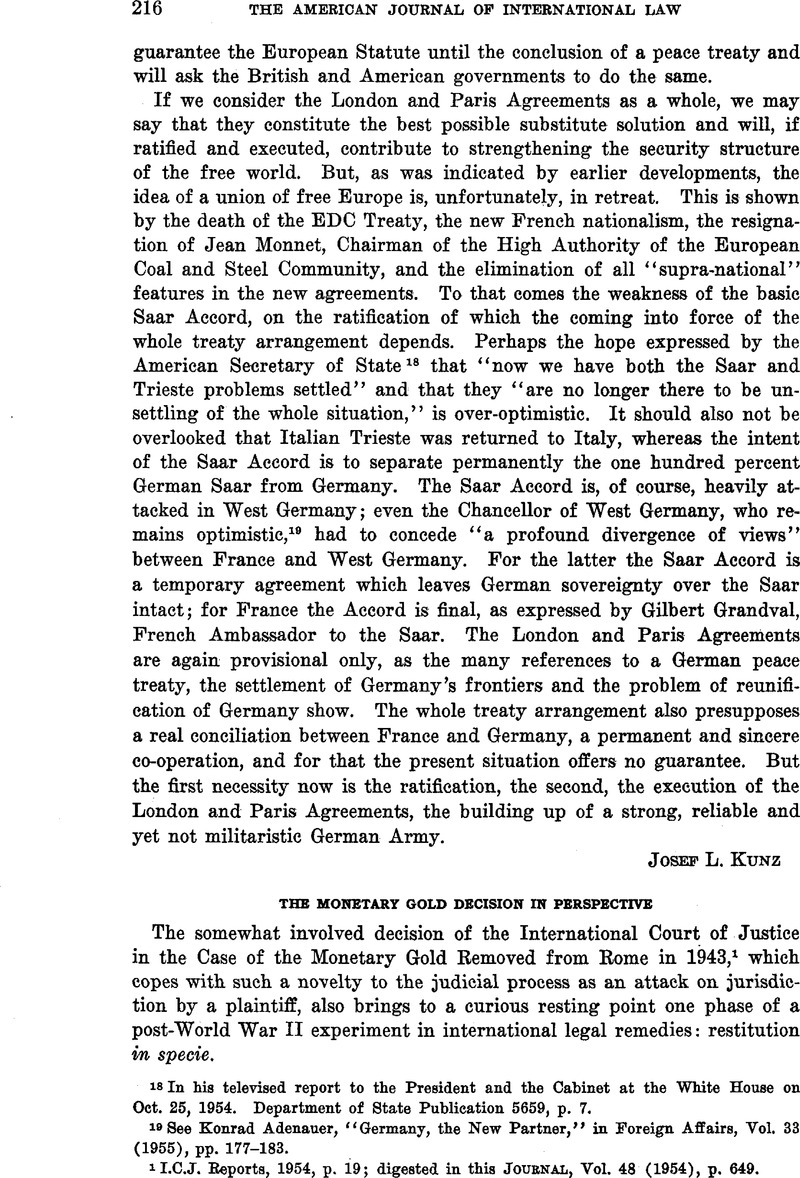Article contents
The Monetary Gold Decision in Perspective
Published online by Cambridge University Press: 30 March 2017
Abstract

- Type
- Editorial Comment
- Information
- Copyright
- Copyright © American Society of International Law 1955
References
1 I.C.J. Reports, 1954, p. 19; digested in this Journal, Vol. 48 (1954), p. 649.
2 A taking by force or duress was dealt with as illegal. Identification of the property was required. Return was made to the government of the country from which the removal took place.
3 Keynes, Economic Consequences of the Peace (1920), esp. pp. 53–55, 226–251.
4 Mantoux, The Carthaginian Peace or The Economic Consequences of Mr. Keynes (Pub. 1946, after the brilliant young French economist author was killed in one of the last engagements of World War II in Europe).
5 The United States, Britain and France resisted reparations claims against Italy on the ground of her incapacity to pay. In the case of Germany, reparations were limited to amounts far smaller than the total of war claims against Germany, being restricted to the taking of German external assets and the removal of certain plant equipment from Germany estimated to be in exeess of that country’s peacetime needs. In contrast, the Soviet Union sought large reparations from Italy, and it was on the Soviet claim for reparations of $10,000,000,000 in current manufactures from Germany that the quadripartite control of Germany foundered. See Clay, Decision in Germany (1950), Ch. 7. The full history of the impact of changing circumstances and conditions on German and Japanese reparation poliey remains to be written.
6 Editorial, this Journal, Vol. 37 (1943), p. 282.
7 A viewpoint which, aside from its economic shortsightedness, also had the disadvantage of supporting by emulation Soviet seizures of industrial property in Manchuria and in Southeastern Europe as “war trophies.”
8 A sidelight of sorts is cast on the lawyer’s rôle in the making of foreign policy through international agreements by the recollection that the American gold pool [sometimes less elegantly called “pot”] had to be explained to the British in terms of the maritime insurance concept of the “general average” and to the continentals [thanks to a suggestion from one of the most scholarly among them] by reference to the Lex Rhodia de Jactu, preserved in the Pandects, Dig. 14.2.1; cf. 3 Kent, Comm. 232, 233.
9 T.I.A.S. No. 1655, in force Jan. 24, 1946; this Journal, Supp., Vol. 40 (1946), p. 117; described in Howard, The Paris Agreement on Reparations from Germany, Dept. of State Bulletin, Vol. 14 (1946), p. 1023 et seq., esp. p. 1027.
10 See ibid., Vol. 15 (1946), p. 563, reporting the establishment of the Commission, Sept. 27, 1946.
11 Established by Part II of the Paris Agreement on Reparation to apply the principles of dividing German assets available to the Western countries for reparation. See Howard, , The Inter-Allied Reparation Agency, Dept. of State Bulletin, Vol. 14 (1946), p. 1063.Google Scholar
12 The Paris Agreement, Part III-G envisaged the possibility that the Allied Powers might get back from certain neutral countries gold they had received from Germany. There were Buch recoveries.
13 Dollfus Meig et Cie., S. A. v. Bank of England, [1950] 1 All E. R. 747; ibid., [1950] 2 All E. R. 605; digested in this Journal, Vol. 44 (1950), p. 592; Vol. 45 (1951), p. 383.
14 Quoted in full in Dept. of State Bulletin, VoL 24 (1951), pp. 785, 786–787.
15 However, the nature of the Italian claim seemed to raise once again the basic question left to the arbitrator; compare the announcement with the signed agreement, cited above, note 14.
16 This writer has not been able to find an original source for the arbitral award, reported to have been made Feb. 20, 1953.
17 Under Charter, Art. 94.
18 As the U. S.-Yugoslav Nationalization Claims Settlement of July 19, 1948.
19 Treaty of Peace with Italy, T.I.A.S. No. 1648, Art. 77; this Journal, Supp., Vol. 42 (1948), p. 75.
20 Literally, as in American tax eases: What is real? What is sham? Refer to the report of the case, in this Journal (cited above, note 1), pp. 652–653.
21 Cf. Rubin, “The Judicial Review Problem in the ITO,” 63 Harvard Law Review (1949) 78.
- 4
- Cited by




